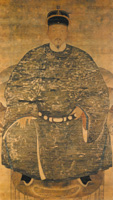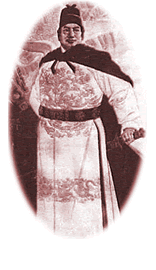 father
took him back to Na’an. At that time women were not allowed to leave
Japan, so he left his mother there. At his father’s demand Koxinga
studied under Confucian scholars, preparing to pass the Chinese imperial
examinations.
father
took him back to Na’an. At that time women were not allowed to leave
Japan, so he left his mother there. At his father’s demand Koxinga
studied under Confucian scholars, preparing to pass the Chinese imperial
examinations.
|
|
|
|
|
|
|
|
|
|
|
|
|

The life of Ming loyalist Koxinga has become a thing of myth and legend. Whilethe facts of his life may be debated, there is no question about the lasting impact he had on the island nation of Taiwan. In 1661 Koxinga expelled the Dutch from Taiwan. He planned to use the island as a base of operations for his campaign against the Manchurian leaders of China, the Qing Dynasty. Koxinga was unsuccessful in his efforts against the Qing, but found success on the island of Taiwan. During his short time there he established a government and ended Western control. Centuries after his death, Koxinga lives on as a Taiwanese folk legend, commemorated in shrines and temples. He is viewed by the Taiwanese as the original ancestor of their nation.
There are few mentions of Taiwan in Chinese history before an explorer of the Ming dynasty announced his discovery of it in 1430. There were few inhabitants on the island, mainly aborigines and a few Chinese merchants and refugees. Over the course of the next century, the island became a refuge for Japanese and Chinese outlaws and rebels. The end of the fifteenth century saw an end to the Ashikaga shogunate in Japan, after which war broke out across the nation. Many Japanese fled the conflicts of their country, turning to piracy and trading. The island of Taiwan proved a good locations to launch their operations from. They claimed the northern port of Chi-lung as their headquarters. There were Chinese pirate-traders as well, and they sailed out of Tainan, a port on the island’s southern coast. The location of Taiwan in relation to other Asian nations, as well as absence of any true government, was perfect for their maritime business. By the end of the 16th century, even more Chinese came to the island, seeking refuge from the rule of the Ming dynasty. This steady stream of immigrants from China led to heightened tensions amongst the Taiwan’s inhabitants. Conflicts arose between the Chinese and the aborigines, followed by problems with the Japanese. These skirmishes were interrupted by the arrival of European nations seeking a base of operations in the Far East.
The Dutch arrived in Taiwan in 1624 as part of the European scramble for territory in Asia. They built defensive forts and forged a strong bond with the native inhabitants. They converted many aborigines to Christianity and later enlisted their support in the struggle against the Chinese settlers. The Dutch made an agreement with the Japanese and Chinese traders on the island, demanding a yearly tribute but vowing not to interfere with them. This agreement proved ineffectual, as conflict between the Japanese and Dutch arose almost immediately. In the Japanese view, the island was rightfully theirs, due to the fact that they had occupied it long before the Dutch arrived. There were several clashes between the two over this issue. However the ending was anticlimactic as the Japanese withdrew from Taiwan on their on accord in 1628. The Spanish moved in to fill the void left by the Japanese, but were permanently expelled from the island in 1642. The Dutch then exercised their supremacy in the area to its fullest. Their fleet became so proficient at harassing other nations’traders that the Dutch had a virtual monopoly in the region.
Koxinga’s hometown was Na’an, in Quanzhou,
Fujian. His father, Zheng Zhilong, was a merchant and pirate, operating
out of China, Taiwan, and Japan He married a Japanese woman, Tamura
Matsu. She gave birth to Zheng Chenggong, who would later become
known as Koxinga in 1624. He was raised by his mother for the first
seven years of his life, then his  father
took him back to Na’an. At that time women were not allowed to leave
Japan, so he left his mother there. At his father’s demand Koxinga
studied under Confucian scholars, preparing to pass the Chinese imperial
examinations.
father
took him back to Na’an. At that time women were not allowed to leave
Japan, so he left his mother there. At his father’s demand Koxinga
studied under Confucian scholars, preparing to pass the Chinese imperial
examinations.
Zheng Zhilong was a powerful pirate, successfully harassing the Chinese coast. In order to limit his attacks on Chinese merchants, the Ming emperor granted him a position of authority in the region. As the Manchus threatened the Ming empire, Zheng Zhilong was appointed head of the Ming navy. He failed at this position, and the struggling Ming fell to the Manchus in 1644. Some Ming princes refused to give up the fight, creating Ming strongholds along the southeastern coast of China. It was Prince Tang who won the support of Zheng Zhilong, and as the prince had no heir of his own, Zheng Zhilong gave him his own son. This is how Zheng Chenggong became called Gou-xing-ye, or “lord ofthe royal surname”, which the Dutch later pronounced as Koxinga.
Despite the gift of his son, Zheng Zhilong was not loyal to Prince Tang’s cause against the Qing. Instead he used his favor with the prince for personal benefit. The Qing attacked Prince Tang in 1646, taking him prisoner. He died in captivity, and when Zheng Zhilong saw the Ming cause was doomed, he quickly surrendered. His behavior was in contradiction to the wishes of Koxinga, who had long been trying to cure his father of his self-serving ways. They parted company. By this time Koxinga’s mother had come to China, and the attacking Qing troops raped and killed her. This only increased Koxinga’s desire for revenge against the Qing. Koxinga took up base in Xiamen and Jinmen and worked with another Ming prince, Prince Gui. Prince Gui gave him the title “Prince of Yanping Prefecture”. Koxinga waged war against the Qing along the coast. The Dutch allowed Koxinga to operate freely in the waters north of Taiwan. The numbers of his troops grew as Chinese fled the new Qing dynasty. Koxinga fought until 1658, but failed to defeat the Qing.
In China, the Qing were utilizing a scorched earth policy against the rebellious Ming loyalists. This left the Ming loyalists with few resources, forcing them to look elsewhere for a base to launch their operations from. After Koxinga gave up his Chinese base, he turned his attention to Dutch possessions in Taiwan. On April 30, 1661, Koxinga and his troops landed at Luerhmen, on the island of Taiwan. He brought 25,000 men, greatly outnumbering the 2,000 Dutch soldiers on the island. Koxinga’s forces laid siege to Taiwan for the next nine months, breaking the will of the Dutch. Upon their surrender, Koxinga allowed to let them fully evacuate with no harassment, quietly ending thirty-eight years of Dutch rule.
The kingdom Koxinga established, called Tung-ning, was ruled by a Ming-style government and a Chinese legal system. The capital was in Tainan. Migrants from China were welcomed to the island, increasing the population to 100,000 by 1683. The influence of Koxinga’s fleet was still so great on the mainland that the Qing government evacuated coastal cities in southern China, moving people inland. Despite his continued dominance, Koxinga would never accomplish his dream of overthrowing the Qing. He died the year after he took Taiwan, 1662.
Koxinga’s son followed in his footsteps, then his grandson. They ruled Taiwan and continued to harass the Chinese. In 1683, the Qing mounted a full-scale naval attack on Taiwan. They defeated the Ming loyalists there, and made Taiwan a prefecture of Fujian province. The Qing government did not pay much attention to Taiwan once they had control of it. They considered it a “frontier area” inhabited by troublemakers and vicious aboriginals.
Koxinga freed Taiwan from the rule of European colonists. This was the beginning of a movement by Eastern nations to remove Western influence and claim control over the region as their own. His status as a sort of folk hero was capitalized on by the Japanese when they gained control of Taiwan at the end of the nineteenth century. Koxinga, the man who expelled the Westerners, was, after all, half Japanese, and Japan used this connection to strengthen their legitmacy with the Taiwanese.
Koxinga’s arrival on Taiwan was of great importance to the island’s history. He left behind a Chinese style government that set the foundation for Taiwan’s Asian identity. The island of Taiwan still has a shrine to Koxinga, whose reputation has grown to mythical proportions. He is considered by many to be the father of their country, the man who freed the island from the Europeans and began the creation of a national identity.
Crozier, Ralph. Koxinga and Chinese Nationalism . Harvard University Press, Cambridge:1977.
Spence, Jonathon D. and John E. Wills, Jr, eds. From Ming to Ch'ing . Yale University Press, New Haven:1979.
So, Kwan-wai. Japanese Piracy in Ming China During the 16th Century . Michigan State University Press:1975.
Yen, Sophia Su-fei. Taiwan in China's Foreign Relations
. The Shoe String Press, Hamben, CT:1965.
http://www.taiwan.com.au/Envtra/SouthWest/Tainan/report04.htmlKoxinga's shrine in Taiwan is discussed in this part of a tourist's guide to the island
http://www.geocities.com/apapadimos/Taiwan_Pages/Taiwan_History_2.htm
This site addresses issues of trade and export in Asia
http://www.taiwan.com.au/Envtra/SouthWest/Tainan/report04.html
A brief overview of Koxinga and Taiwan
http://www.taiwandocuments.org/koxinga.htm
Exact text of the agreement Koxinga signed with the Dutch
http://www.etaiwannews.com/History/2001/04/30/988602340.htm
Historical background of Koxinga and Taiwan
Site Created by: Amy Popieski